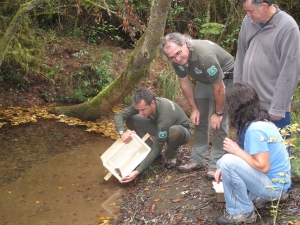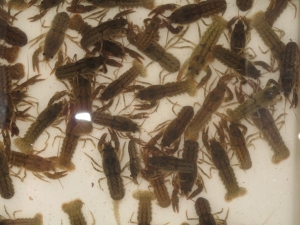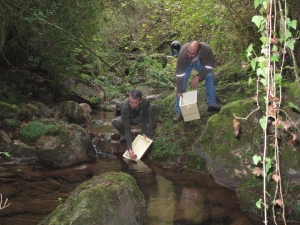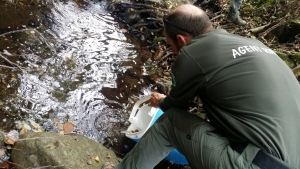Native crayfish are released in the basins of the Ter, Fluvià and Muga rivers
The LIFE Project Potamo Fauna have released up to 700 individuals during this autumn
One of the main objectives of the European project LIFE Potamo Fauna "Conservation of river fauna of Community interest in the Natura 2000 network sites of the Ter, Fluvià and Muga river basins” is the conservation and recovery of the White-clawed Crayfish (Austropotamobius pallipes), a species that is seriously threatened. With this premise, captive-bred specimens of the Breeding Center in Olot have been released during this fall, between late October and early November, up to 687 individuals. The releases were carried out in co-operation with the Cos d’Agents Rurals and took place in the three basins where they work. Specifically, the places were in Sant Jaume de Llierca in the basin of Fluvià River, where 224 crayfish have been released, in Sant Feliu de Pallerols in the Ter basin 187 individuals and up to 276 in the basin of the Muga. Until 2017, when the project Potamo Fauna will last, the reinforcements are held in eight sectors of Natura 2000 network of the surrounding region.
The native crayfish species was common in most water courses in southern Europe. In the late seventies an epizootic fungus Aphanomyces astaci of crayfish plague occurred, which caused a drastic decrease of the population. This was introduced by some invasive crayfish, a species that has spread quickly around rivers of the country. The expansion of the diseases has been accentuated by the recent expansion of two exotic crayfish, both of American origin and carriers of diseases.
In the basin of the river Fluvià over 20 years we are working with the knowledge of this species and 10 recovery plans. In 2004 the Center for Reproduction of native crayfish was created in Olot, managed by the technical team of the Garrotxa Volcanic Zone Natural Park. In the framework of the LIFE Potamo Fauna it has been able to bring improvements to the facilities to minimize diseases such as Saprolegnia and thus increase the production of crayfish. This year, the center has reaching 1,500 individuals. Today there is a great stock of individuals from different watersheds in the country, and also juveniles from its captive breeding and will be useful to increase the number of breeding crayfishes. The units are players from the three major basins in the province of Girona (Fluvià, Ter and Muga), thus preserving the genetic diversity of each river basin and can work on finding resistance to the diseases depending genetics of each population. With the repopulation it is expected in the short term to avoid the disappearance of 32 existing populations in the area of action and to establish between 15 and 20 new population in areas where the species has disappeared.
This work is conducted jointly by the Department de Territori i Sostenibilitat off the Generalitat de Catalunya, through the Garrotxa Volcanic Zone Natural Park, Forestal Catalana and the Consorci de l’Estany through LIFE Potamo Fauna, which also are partners with the Consorci del Ter, Amics de les Tortugues de l’Albera and the Universidad del País Vasco-Euskal Herriko Unibertsitabea.
LIFE Fauna Potamo is a four-year project (2014-2017) which is financed by European funds by 50%. Apart from the White-clawed Crayfish also works in the conservation of other endangered species as the Naiad Unio elongatulus, European Pond Turtle (Emys orbicularis), and two species of Narrow-mouthed Wnorl Snail (Vertigo angustior and Vertigo moulinsiana). The projects also works in the fighting against various alien invasive species.




















